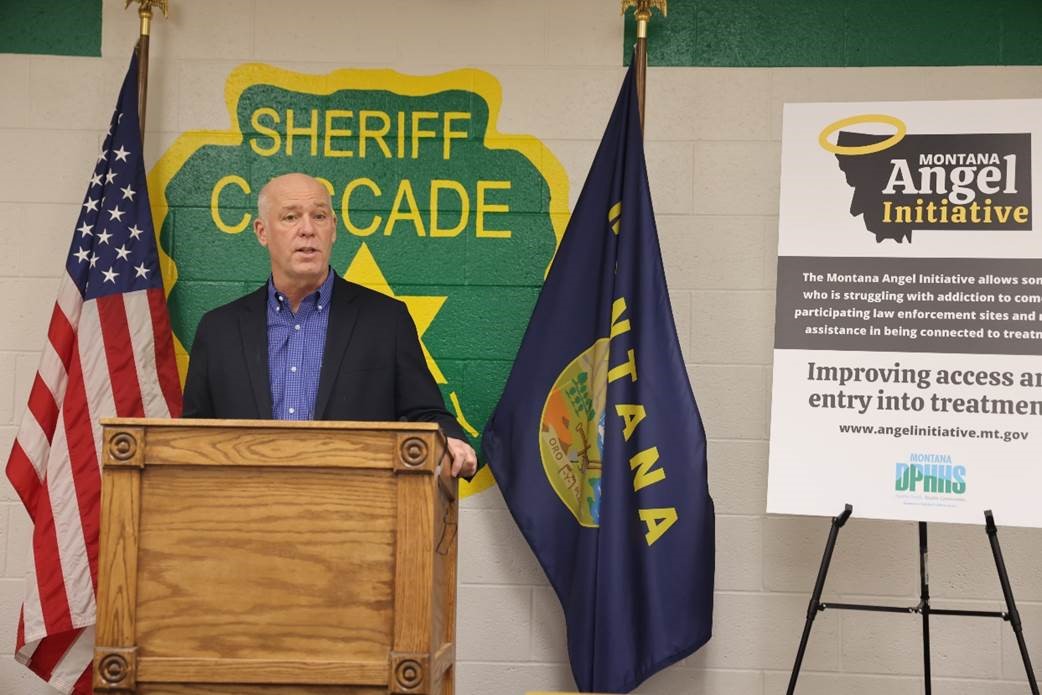FOR IMMEDIATE RELEASE
Date: November 09 2021
Contact: Jon Ebelt, Public Information Officer, DPHHS, (406) 444-0936
Chuck Council, Communications Specialist, DPHHS, (406) 444-4391
Gov. Gianforte, DPHHS Launch Angel Initiative To Increase Access to Treatment
GREAT FALLS, Mont. – Today with Montana Department of Public Health and Human Services Director Adam Meier, Cascade County Sheriff Jesse Slaughter, and Rimrock CEO Lenette Kosovich, Governor Greg Gianforte announced a new initiative by the state to address Montana’s substance abuse crisis.
Launched today at the Cascade County Sheriff’s Office, the Angel Initiative improves access to substance abuse treatment for Montanans through increased entry points to treatment and coordination with participating law enforcement partners.
“Montana faces a substance abuse crisis, and we must do all we can to connect Montanans who need help to treatment,” Governor Gianforte said. “Under the leadership of Director Meier, DPHHS is thinking outside of the box to reduce the stigma associated with treatment and guide individuals on the path to recovery.”

Gov. Gianforte launches the Angel Initiative at the Cascade County Sheriff’s Office.
A collaborative effort among Governor Gianforte, DPHHS, participating law enforcement entities, and treatment providers, the Angel Initiative allows someone who is struggling with addiction and substance use to go into any participating law enforcement office and receive assistance to connected with treatment. To date, nearly 20 Montana sheriff’s offices have committed to join the effort.
“We’re pleased that the Cascade County sheriff and other sheriffs across the state are participating in the Angel Initiative,” DPHHS Director Meier said. “We’re thrilled to be partnering with law enforcement and treatment providers to guide folks on the path to recovery and save lives.”
Cascade County is considered the first site to launch the new effort. Other participating sites will become active after state-coordinated trainings scheduled for November and December, with the goal of having all sites trained by the new year.
“I believe this program has great potential, and we’re excited to join the effort,” Sheriff Slaughter said. “In the end, we all have the same goal: keep our communities safe and help connect Montanans with the treatment they need. When that happens, we all win. Families stay together, children are safer, and people stay out of the judicial system.”
A toll-free number connects law enforcement to the Angel Line where a mental health professional will assess the level of care an individual may need. If there is no availability in the local community, the Angel Line will provide alternate options for treatment in nearby communities. A placement for treatment is not guaranteed, and the participant may be placed on a wait list.
Kosovich said Rimrock is committed to working directly with law enforcement and other providers to help connect Montanans with treatment.
“We fully understand the toll that substance use disorders continue to take on Montanans, and this is yet another tool that can help connect people with the treatment they need,” Kosovich said. “We are eager to work with law enforcement and with all treatment providers as we work together to move this initiative forward.”
The state is also working with the Behavioral Health Alliance of Montana to enroll substance abuse providers. To date, a total of nine providers representing over 20 counties have joined the Angel Initiative.
Meier said similar programs have been successful in other states, citing the Kentucky State Police starting a similar initiative in 2016 with all 16 Kentucky State Police Posts participating. The program has helped placed several hundred individuals seeking assistance in treatment programs.
Information about the new program is available at angelinitiative.mt.gov. The website features a map of participating locations, including specific contact information for each location.
The governor cited several key statistics describing the impact in Montana:
- DPHHS estimates that approximately 90,000 Montanans have a substance use disorder, but realistically only a fraction of these people seek treatment in any given year.
- While opioids still account for the largest percentage of drug overdoses in the state, methamphetamine-related deaths, hospitalizations, and emergency department visits in Montana have increased over the last few years. Approximately 12,900 adolescent and adult Montanans used methamphetamine between 2009 and 2019.
- In 2019, the annual methamphetamine-related death rate in Montana was 7.2 per 100,000 people, exceeding the national average of 5.7 per 100,000 people.
- Furthermore, over 65 percent of Child and Family Services Division substance-use related placements list methamphetamine as the primary drug.
From January through September 2021, the state averaged 69 opioid overdose calls per month. And, from late spring through summer 2021, Montana saw some of the highest opioid overdose monthly call volumes in the last three years, with 82 calls in July as the highest during that time frame.

